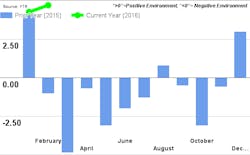That positive vibe you might be feeling right now isn’t a mirage. According to the Shippers Conditions Index (SCI), tracked on a monthly basis by transportation forecasting firm FTR, conditions improved for the fourth month in a row, as of February 2016, when the index rose to 4.7. Any reading above zero indicates favorable conditions for shippers.
FTR’s analysis suggests that the index will remain relatively positive for shippers in 2016 before starting a steady move downward towards year end and likely lasting through 2018 as a regulatory-driven capacity crunch takes hold, save any onset of a recession. Currently, capacity utilization has moderated on all transport modes taking pressure off labor and shipping costs. FTR’s outlook continues to show a softening in the freight economy through 2016.
“Although the SCI has retreated somewhat it still remains in positive territory,” points out Larry Gross, partner and senior consultant at FRT. “Channel checks with shippers and carriers confirm that relatively favorable conditions from the standpoint of shippers are giving them more sway in carrier negotiations than they have had in some time.”
That being said, Gross is forecasting a slow deterioration as the year goes on, but he notes that “tepid demand growth will continue to keep things relatively calm until the electronic logging device (ELD) mandate approaches as we move into next year.”
Meanwhile, according to the Cass Freight Index, North American freight shipments rose in the month of April, but at a much lower rate (0.6%) than earlier in the year. What’s more, the April 2016 freight shipments index is nearly 5% (4.9%) lower than the comparable period a year ago.
“The U.S. economy decelerated in the first four months of 2016,” observes Rosalyn Wilson, president of FreightMatters, a consulting firm providing transportation sector analysis. “The slowdown was caused by the continued decline of the global economy; the reticence of the consumer sector to increase its buying; the loss of jobs and income from the plunging oil costs (which shut down the fracking business and cut back on coal shipments); very high inventory levels across the entire supply chain; and poor export figures due to both the strength of the U.S. dollar and a decline in worldwide demand.”
All eyes right now are on the Chinese economy, Wilson points out, due to its extreme instability, and the fear that as China falters, so too could the world economy. “Based on the trends of many economic indicators, it appears the economy may get worse before it gets better.”




